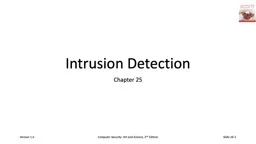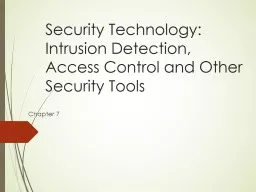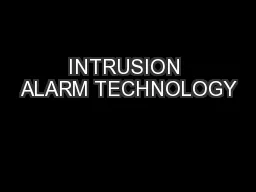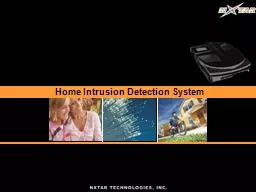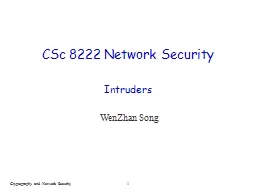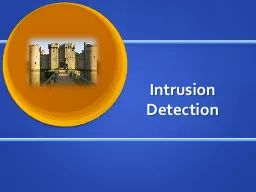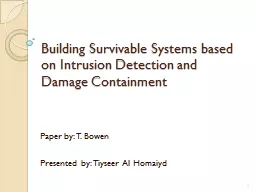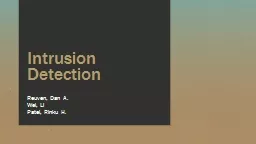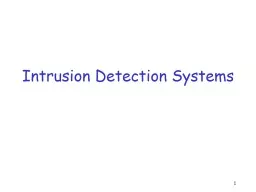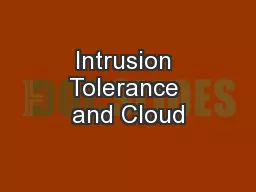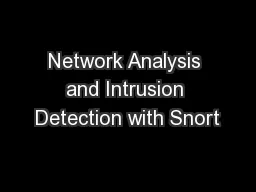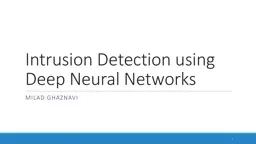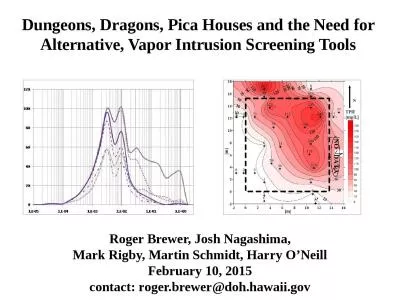PPT-Intrusion Detection Chapter 25
Author : ellena-manuel | Published Date : 2020-04-06
Version 10 Computer Security Art and Science 2 nd Edition Slide 26 1 Overview Principles Basics Models of Intrusion Detection Architecture of an IDS Organization
Presentation Embed Code
Download Presentation
Download Presentation The PPT/PDF document " Intrusion Detection Chapter 25" is the property of its rightful owner. Permission is granted to download and print the materials on this website for personal, non-commercial use only, and to display it on your personal computer provided you do not modify the materials and that you retain all copyright notices contained in the materials. By downloading content from our website, you accept the terms of this agreement.
Intrusion Detection Chapter 25: Transcript
Version 10 Computer Security Art and Science 2 nd Edition Slide 26 1 Overview Principles Basics Models of Intrusion Detection Architecture of an IDS Organization Incident Response. And 57375en 57375ere Were None meets the standard for Range of Reading and Level of Text Complexity for grade 8 Its structure pacing and universal appeal make it an appropriate reading choice for reluctant readers 57375e book also o57373ers students Chapter 7. Intrusion. “Intrusion is a type of attack on information assets in which the instigator attempts to gain entry into a system or disrupt the normal operation of system with, almost always, the intent to do malicious harm.”. INTRO TO INTRUSION ALARM. INTRUSION ALARM TECHNOLOGY. An intrusion detection system consists of several different system components wired together to provide protection of persons and property.. INTRUSION ALARM TECHNOLOGY. Main Advantages. H . 2. 1. Fiber Optics Technology. . -Covert design. Caused no physical alteration to present building outlook. -Full Fiber Structure thus immune to lightning strike and EMI. Intruders. WenZhan. Song. Cryptography and Network Security. 1. Intruders. Three classes of intruders:. Examples of Intrusion. Performing a remote root compromise of an e-mail server. Defacing a Web server. Intruders. Classes (from [ANDE80]:. two most publicized threats to security are malware and intruders. generally referred to as a . hacker. or . cracker. Examples of Intrusion. remote root compromise. Paper by: T. Bowen. Presented by: Tiyseer Al Homaiyd. 1. Introduction: . Intrusions: show observable events that deviate from the . norm.. Survivable system usually focus on detecting intrusions rather than preventing or containing damage. . Reuven, Dan A. .. Wei. , Li. Patel, Rinku H. .. Background. Definition of Intrusion Detection. A device dedicated to monitoring network and system resources of a company for signs of malicious activity or unauthorized access. &. Intrusion . Detection Systems. 1. Intruders. Three classes of intruders:. Examples of Intrusion. Performing a remote root compromise of an e-mail server. Defacing a Web server. Guessing and cracking passwords. C. Edward Chow . Department of Computer Science. Outline of the Talk. Overview of . DDoS. Intrusion Tolerance with Multipath Routing . Secure DNS with Indirect Queries/Indirect Addresses. Multipath Indirect Routing. Snort. Freeware.. Designed as a network sniffer.. Useful for traffic analysis.. Useful for intrusion detection. .. Snort. Snort is a good sniffer.. Snort uses a detection engine, based on rules.. Packets that do not match any rule are discarded.. Christopher Markley, PhD. US Nuclear Regulatory Commission. National Academy of Sciences: Recommendations for Human Intrusion Standards. Not possible to make scientifically supportable predictions of the probability of human intrusion.. Milad Ghaznavi. 1. Outline. Introduction. Dataset. Multi Layer Perceptron. Convolutional Neural Network. Evaluation. Related Work. Conclusion. 2. Introduction. Intrusion Detection. Background. 3. Intrusion Detection. Roger . Brewer, Josh Nagashima,. Mark Rigby, Martin Schmidt, Harry O’Neill. February 10, . 2015. contact: roger.brewer@doh.hawaii.gov. Reference. Roger . Brewer & Josh Nagashima. : Hawai’i Dept of Health.
Download Document
Here is the link to download the presentation.
" Intrusion Detection Chapter 25"The content belongs to its owner. You may download and print it for personal use, without modification, and keep all copyright notices. By downloading, you agree to these terms.
Related Documents

